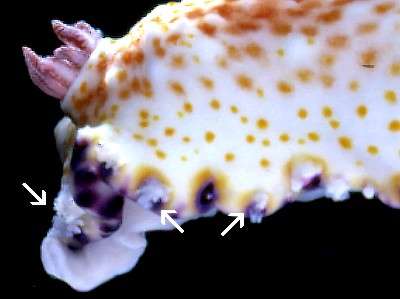Do chromodorid mantle glands have a pore?
November 9, 1999
From: Bill Rudman

While preparing a page on Chromodoris aureopurpurea I came across this photo I took of an animal showing the extrusion of the intact mantle glands from a 'pore' in the dorsal surface of the mantle. In every case the 'pore' was in the centre of the dark purple spots around the mantle edge.
There is considerable debate about how the distasteful metabolites within the mantle glands (Mantle Dermal Formations) are 'released' or come into contact with potential predators. On one hand, as Garcia et al (1991) have shown, it is not possible to find a pore in the mantle epithelium for secretion to take place. However as you can see in my photo of Glossodoris rubroannulata accompanying my answer to an earlier question, some species do produce a milky substance which appears to be secreted.
This photo of C. aureopurpurea suggests that more than one means of delivering the metabolites may be used by different species. In this case it appears that the whole branching gland has 'popped out'. As all the glands have emerged in the same place, from a purple spot, it would suggest that this is not just a random breaking of the skin, but through a structural 'weak spot' or pore.
What caused the animal to do this? It happened the night the animal had been caught and was apparently stressed. I have often seen specimens of Hypselodoris 'pop' out their single unbranched glands around the posterior end of the mantle, usually when they are being narcotised.
I add this observation to the general debate.
Bill Rudman.
[Specimen from: Green Point, Sydney Harbour, New South Wales, Australia. 7m, June 1982, 34mm long alive].
References:
•Avila, C. & Durfort, M. (1996). Histology of Epithelia and Mantle Glands of selected species of Doridacean mollusks with chemical defensive strategies. The Veliger, 39(2): 148-163.
•Garcia, J.C., Medina, A. & Coveras, R. (1991). Study of the anatomy and histology of the mantle dermal formations (MDFs) of Chromodoris and Hypselodoris (Opisthobranchia: Chromodorididae). Malacologia, 32(2): 233-240.
Related messages
-
Re: Predation by Humans?
From: Peter H. van Bragt, September 28, 2001 -
Re: Predation by Humans?
From: Scott Johnson, September 17, 2001 -
Predation by Humans?
From: Peter H. van Bragt, September 16, 2001 -
Natural products from Sea Slugs
From: Arnaud Parenty, March 2, 2001 -
Sea Slugs producing sulfuric acid
From: Foisy, May 2, 2000 -
Chemical Defences in nudibranchs
From: Victor Bonito, April 30, 2000 -
Chemical defence & reproductive strategies
From: Sarah Priestley, November 15, 1999 -
Re: Defensive allomones in nudibranchs
From: Wayne Ellis, June 7, 1999 -
Aposematism - experimental evidence?
From: Russell Wyeth, June 7, 1999 -
Defensive allomones in nudibranchs
From: Dan Sanchez, June 6, 1999 -
Defensive Glands in Hypselodoris
From: Austin, May 21, 1999 -
Re: Defensive Glands in Hypselodoris
From: Bill Rudman, May 21, 1999 -
defensive secretions
From: Patrick Krug, Ph.D., September 9, 1998 -
Mucus as a means of defense
From: Andrea Stephenson, March 28, 1998
